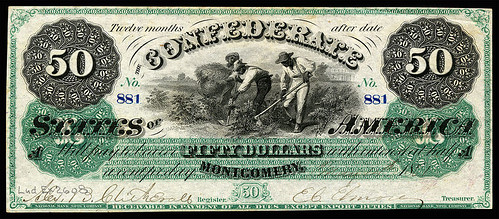
PREV ARTICLE
NEXT ARTICLE
FULL ISSUE
PREV FULL ISSUE
OBJECT OF INTRIGUE: CONFEDERATE CURRENCY
On March 1, 2016 the Atlas Obscura blog published an article on Confederate Currency. It's nicely done; here's an excerpt,
but be sure to read the complete version online. -Editor

American banknotes today feature mighty presidents of yore, grand buildings of the nation’s capital, and eagles. In 1861, the banknote imagery of choice included brand-new railroads, Greek goddesses, and slavery. When Deep South states seceded to form the Confederacy in early 1861, they started issuing their own currency. The first series of Confederate States dollars was introduced in April 1861, on the eve of the Civil War. Each bill was stamped with a mishmash of imagery intended to inspire, but none more strikingly so than the $50 and later $100 notes, which depicted, among other vignettes, a trio of slaves working in a cotton field. 
Romanticized depictions of slavery on banknotes were not a new concept at the time. Individual banks in southern states had been putting images of slaves working the fields on their bills since the 1850s. (The 19th century was the height of the Free Banking Era, a time of unregulated, decentralized economics in which individual banks could issue their own currency.) With the dawn of the Civil War, however, Confederate bank notes became scraps of Southern hope in the fight to retain slavery. The initial 1861 series was followed by six more sets of notes, with the final series issued in 1864. Each bill was a pocket-sized piece of Confederate propaganda that could be spread far and wide—within the southern states, and up into the Union. In putting images of slaves hoeing cotton fields, loading carts, or carrying bags of corn on its currency, the Confederacy affirmed its unashamed reliance on slavery as a fundamental part of the Southern economy. Furthermore, as Louisiana State University journalism professor Jules d’Hemecourt put it, stamping the cash with such imagery alongside mythological Greek gods and goddesses made a dogged statement that slavery “would continue to exist in perpetuity, protected by law and sanctioned by tradition, and all but divinely ordained in iconography.” There are a few places where these banknotes have been particularly well preserved. The Boston Athenaeum currently holds over 6,000 pieces of Confederate paper currency in its collection, with much of it viewable online. The images also live on in remixed forms. South Carolina artist John W. Jones—himself a descendent of slaves—has created a series of colorful acrylic paintings based on the Confederate banknotes' slavery vignettes, entitled "The Color of Money." In his words, the images on the currency are “a visual smoking gun that documents how much free slave labor enriched America.” To read the complete article, see:
Wayne Homren, Editor The Numismatic Bibliomania Society is a non-profit organization promoting numismatic literature. See our web site at coinbooks.org. To submit items for publication in The E-Sylum, write to the Editor at this address: whomren@gmail.com To subscribe go to: https://my.binhost.com/lists/listinfo/esylum All Rights Reserved. NBS Home Page Contact the NBS webmaster 
|